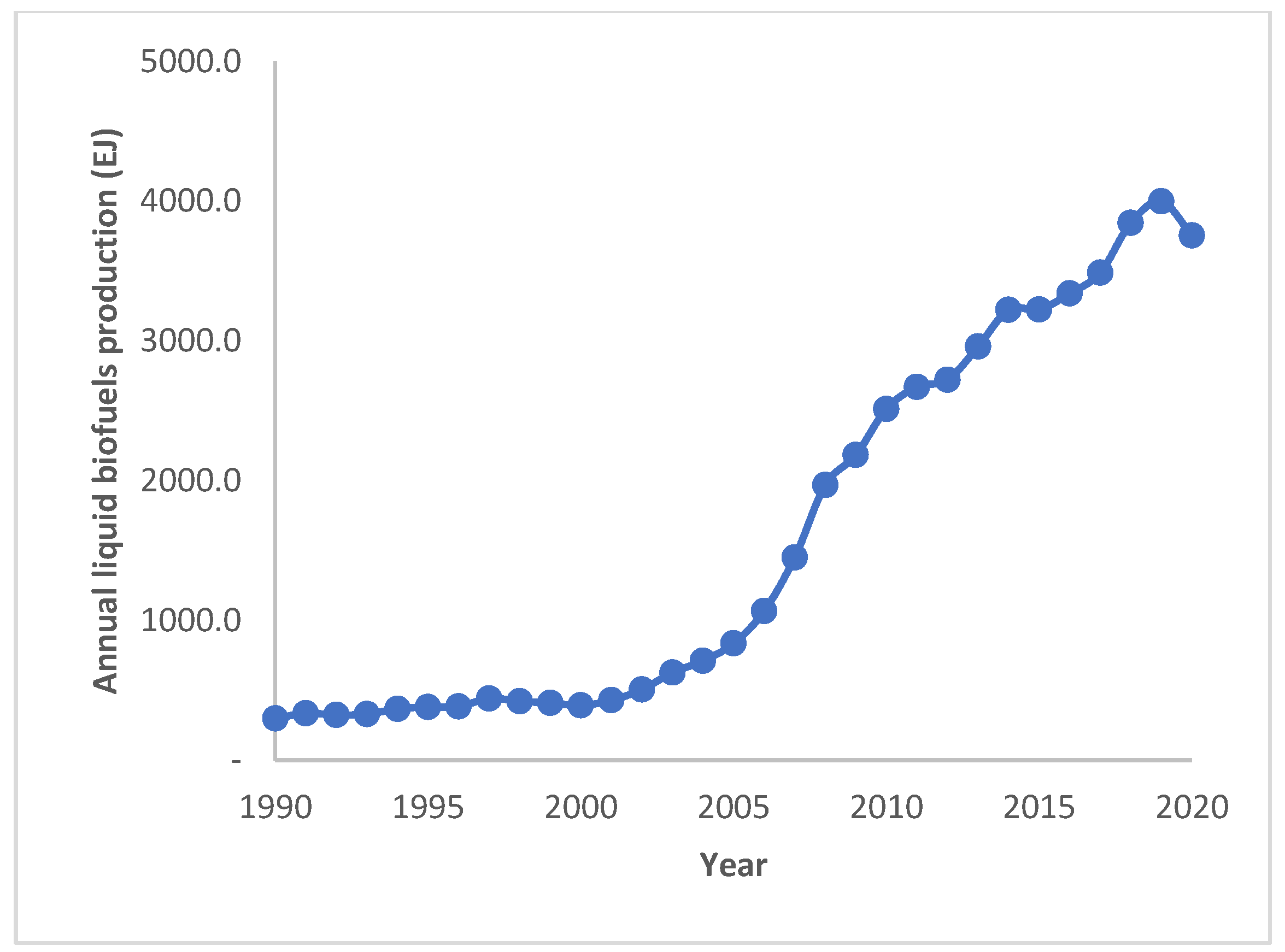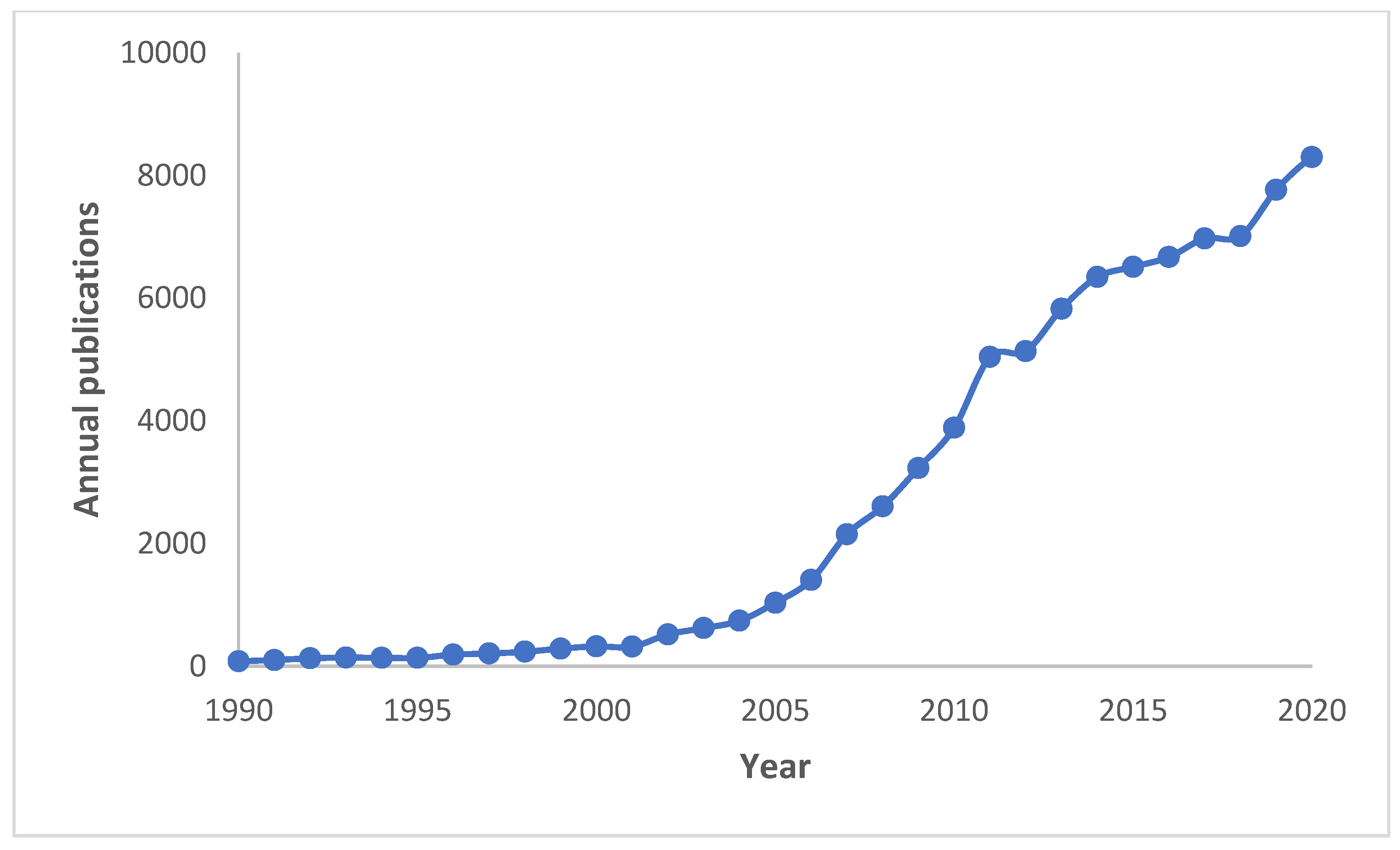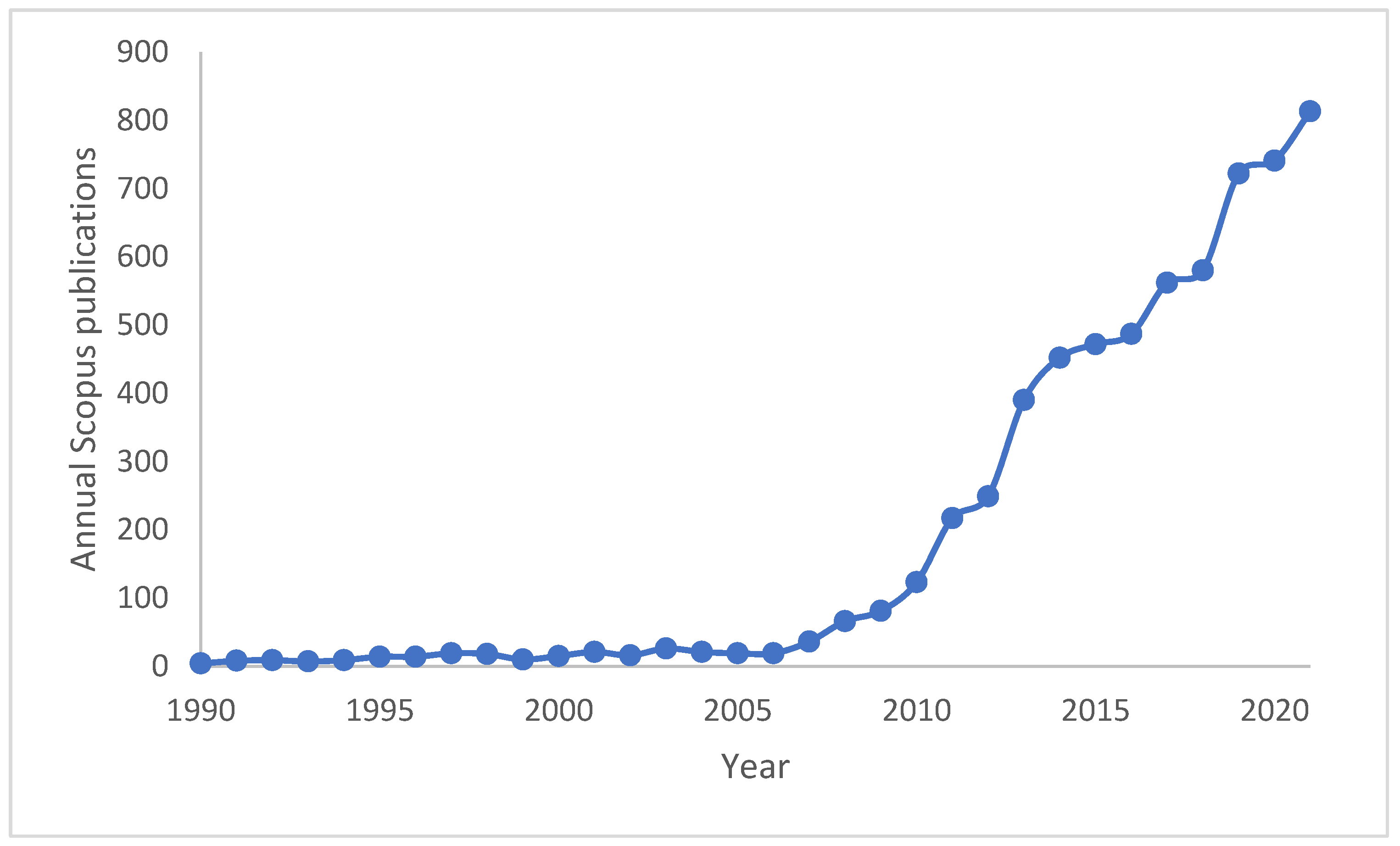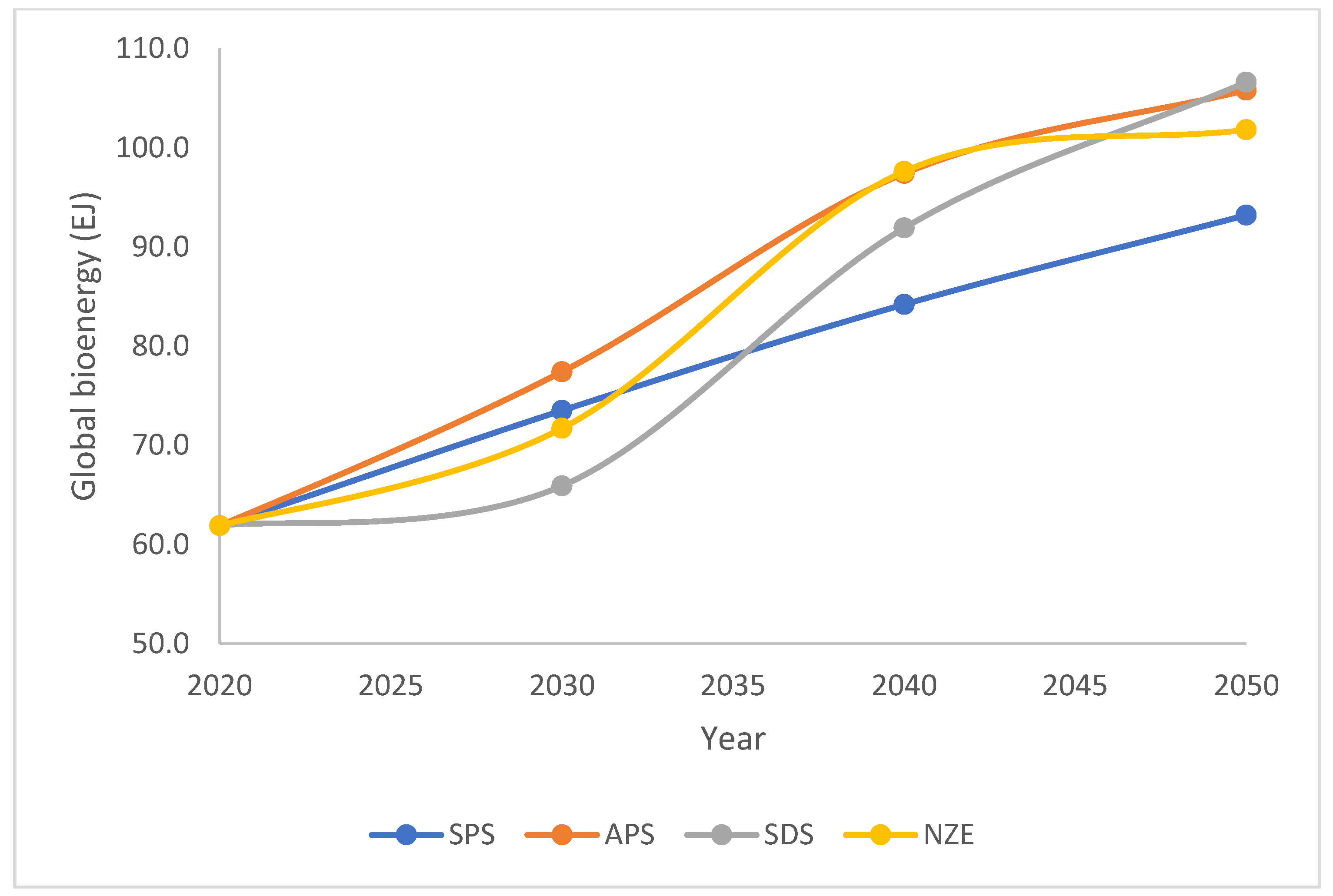Can Bioenergy Once again Become a Major Global Energy Source?
Abstract
:1. Introduction
2. Methodology
3. Technical Potential for Bioenergy
4. Bioenergy and Climate Change
- Wood has a much lower heating value, and so its CO2/kWh is higher, which creates an initial carbon debt.
- Regrowth of forest on the land harvested will remove CO2 from the atmosphere—assuming regrowth is allowed to occur. However, any such regrowth takes many decades.
- Until full regrowth occurs, atmospheric CO2 levels will be higher than for coal-fired power, so CO2-induced radiative forcing will be higher. Yet, we need to seriously reduce climate forcing in the next decade or two.
5. The Future for Bioenergy
- Agricultural residues: 38.8 EJ
- Forestry residues: 11.8 EJ
- Municipal solid wastes: 11.8 EJ
- Manure: 7.0 EJ
- Waste oils: 1.5 EJ.
6. Conclusions
Funding
Institutional Review Board Statement
Informed Consent Statement
Data Availability Statement
Conflicts of Interest
Nomenclature
| APS | Announced Pledges Scenario |
| BECCS | bioenergy carbon capture and sequestration |
| CCS | carbon capture and sequestration |
| CDR | carbon dioxide removal |
| CO2 | carbon dioxide |
| CO2-eq | carbon dioxide equivalent |
| EJ | exajoule = 1018 joule |
| (EIA) | Energy Information Agency |
| EOH | ethanol |
| EROEI | energy return on investment |
| ETBE | Ethyl tertiary-butyl ether |
| EV | electric vehicle |
| FAO | Food and Agriculture Organization |
| FF | fossil fuel |
| GHG | greenhouse gas |
| GJ | gigajoule = 109 joule |
| Gt | gigatonne = 109 tonne |
| HANPP | human appropriation of Net Primary Production |
| ICEV | internal combustion engine vehicle |
| IEA | International Energy Agency |
| IPCC | Intergovernmental Panel on Climate Change |
| MJ | megajoule = 106 joule |
| NPP | Net Primary Production |
| NZE | Net-Zero Emissions |
| OECD | Organisation for Economic Co-operation and Development |
| OPEC | Organization of the Petroleum Exporting Countries |
| RE | renewable energy |
| RFS | Renewable Fuel Standard |
| SDS | Sustainable Development Scenario |
| SPS | Stated Policies Scenario |
References
- Moriarty, P.; Honnery, D. Switching off: Meeting Our Energy Needs in a Constrained Future; Springer: Singapore, 2022; 90p, ISSN 2191-5520. [Google Scholar]
- Smil, V. Energy Transitions: History, Requirements, Prospects; Praeger: Santa Barbara, CA, USA, 2010. [Google Scholar]
- International Renewable Energy Agency (IRENA). International Renewable Energy Statistics 2021. 2021. Available online: https://irena.org/publications/2021/Aug/Renewable-energy-statistics-2021 (accessed on 23 June 2022).
- International Energy Agency IEA. World Energy Outlook 2021; IEA/OECD: Paris, France, 2021; Available online: https://www.iea.org/topics/world-energy-outlook (accessed on 24 June 2022).
- Moriarty, P.; Honnery, D. Energy accounting for a renewable energy future. Energies 2019, 12, 4280. [Google Scholar] [CrossRef]
- Meng, L. Chapter 11—Ethanol in automotive applications. In Ethanol Science and Engineering; Basile, A., Iulianelli, A., Francesco Dalena, F., Eds.; Elsevier: Amsterdam, The Netherlands, 2019; Available online: https://doi.org/10.1016/B978-0-12-811458-2.00011-0 (accessed on 21 May 2022). [CrossRef]
- Wikipedia. Renewable Fuel Standard (United States). 2022. Available online: https://en.wikipedia.org/wiki/Renewable_Fuel_Standard_(United_States) (accessed on 28 May 2022).
- Lark, T.J.; Hendricks, N.P.; Smith, A.; Gibbs, H.K. Environmental outcomes of the US Renewable Fuel Standard. Proc. Natl. Acad. Sci. USA 2022, 119, e2101084119. [Google Scholar] [CrossRef] [PubMed]
- Wikipedia. Corn Ethanol. 2022. Available online: https://en.wikipedia.org/wiki/Corn_ethanol (accessed on 22 June 2022).
- van der Waals, M.J.; Plugge, C.; Meima-Franke, M.; de Waard, P.; Bodelier, P.L.E.; Smidt, H.; Gerritse, J. Ethyl tert-butyl ether (EtBE) degradation by an algal-bacterial culture obtained from contaminated groundwater. Water Res. 2019, 148, 314–323. [Google Scholar] [CrossRef]
- BP. BP Statistical Review of World Energy 2021; BP: London, UK, 2021; Available online: https://www.bp.com/en/global/corporate/energy-economics/statistical-review-of-world-energy.html (accessed on 28 June 2022).
- Renewable Fuels Association (RFA). Annual Ethanol Production. 2022. Available online: https://ethanolrfa.org/markets-and-statistics/annual-ethanol-production (accessed on 27 April 2022).
- United Nations (UN). World Population Prospects 2019; UN: New York, NY, USA, 2019; Available online: https://population.un.org/wpp/ (accessed on 27 April 2022).
- Wikipedia. Biofuel in the European Union. 2022. Available online: https://en.wikipedia.org/wiki/Biofuel_in_the_European_Union (accessed on 3 July 2022).
- Wikipedia. Cellulosic Ethanol. 2022. Available online: https://en.wikipedia.org/wiki/Cellulosic_ethanol (accessed on 29 June 2022).
- Service, R.F. Can biofuels really fly? Science 2022, 376, 1394–1397. [Google Scholar] [CrossRef]
- Plötz, P.; Axsen, J.; Funke, S.A.; Gnann, T. Designing car bans for sustainable transportation. Nat. Sustain. 2019, 2, 534–536. [Google Scholar] [CrossRef]
- International Energy Agency (IEA). Global EV Outlook; IEA/OECD: Paris, France, 2021; Available online: https://www.iea.org/reports/global-ev-outlook-2021 (accessed on 25 March 2022).
- Moriarty, P. Electric vehicles can have only a minor role in reducing transport’s energy and environmental challenges. AIMS Energy J. 2022, 10, 131–148. [Google Scholar] [CrossRef]
- Le Page, M. EU plan to cut emissions from planes may increase them. New Sci. 2022, 254, 15. [Google Scholar] [CrossRef]
- Ubando, A.T.; Felix, C.B.; Chen, W.H. Biorefineries in circular bioeconomy: A comprehensive review. Bioresour. Technol. 2020, 299, 122585. [Google Scholar] [CrossRef]
- Vogelpohl, T.; Töller, A.E. Perspectives on the bioeconomy as an emerging policy field. J. Environ. Pol. Plan. 2021, 23, 143–151. [Google Scholar] [CrossRef]
- Yang, L.; Wang, X.-C.; Dai, M.; Yang, L.; Wang, X.-C.; Dai, M.; Chen, B.; Qiao, Y.; Deng, H.; Zhang, D.; et al. Shifting from fossil-based economy to bio-based economy: Status quo, challenges, and prospects. Energy 2021, 228, 120533. [Google Scholar] [CrossRef]
- International Energy Agency (IEA). Key World Energy Statistics 2021; IEA/OECD: Paris, France, 2021; Available online: https://www.iea.org/reports/key-world-energy-statistics-2021 (accessed on 24 May 2022).
- Intergovernmental Panel on Climate Change (IPCC). Climate Change 2021: The Physical Science Basis; AR6, WG1; Cambridge University Press: Cambridge, UK, 2021. [Google Scholar]
- Intergovernmental Panel on Climate Change (IPCC). Climate Change 2022: Mitigation of Climate Change. 2022. Available online: https://www.ipcc.ch/report/ar6/wg3/ (accessed on 17 June 2022).
- Energy Information Agency (EIA). International Energy Outlook 2021 (IEO2021). 2021. Available online: https://www.eia.gov/outlooks/ieo/ (accessed on 14 May 2022).
- ExxonMobil. Outlook for Energy: Data Pages. 2021. Available online: https://corporate.exxonmobil.com/Energy-and-innovation/Outlook-for-Energy (accessed on 14 May 2022).
- Organization of the Petroleum Exporting Countries (OPEC). 2021 OPEC World Oil Outlook; OPEC: Vienna, Austria, 2021; Available online: http://www.opec.org (accessed on 14 May 2022).
- Shell. The Energy Transformation Scenarios. 2020. Available online: https://www.shell.com/promos/energy-and-innovation/download-full-report/_jcr_content.stream/1627553067906/fba2959d9759c5ae806a03acfb187f1c33409a91/energy-transformation-scenarios.pdf (accessed on 14 May 2022).
- BP. BP Energy Outlook, 2022 ed; BP: London, UK, 2022; Available online: https://www.bp.com/content/dam/bp/business-sites/en/global/corporate/pdfs/energy-economics/energy-outlook/bp-energy-outlook-2022.pdf (accessed on 12 June 2022).
- DNV. Energy Transition Outlook 2021: Executive Summary; DNV: Bærum, Norway, 2021; Available online: DNV_ETO_Executive_summary_2021_singel_highres.pdf (accessed on 15 June 2022).
- Moriarty, P.; Honnery, D. Review: Assessing the climate mitigation potential of biomass. AIMS Energy J. 2017, 5, 20–38. [Google Scholar] [CrossRef]
- Schramski, J.R.; Gattie, D.K.; Brown, J.H. Human domination of the biosphere: Rapid discharge of the earth-space battery foretells the future of humankind. Proc. Natl. Acad. Sci. USA 2015, 112, 9511–9517. [Google Scholar] [CrossRef] [PubMed]
- Foley, J.A.; Monfreda, C.; Ramankutty, N.; Zaks, D. Our share of the planetary pie. Proc. Natl. Acad. Sci. USA 2007, 104, 12585–12586. [Google Scholar] [CrossRef] [PubMed]
- Krausmann, F.; Erb, K.-H.; Gingrich, S.; Haberl, H.; Bondeau, A.; Gaube, V.; Lauk, C.; Plutzar, C.; Searchinger, T.D. Global human appropriation of net primary production doubled in the 20th century. Proc. Natl. Acad. Sci. USA 2013, 110, 10324–10329. [Google Scholar] [CrossRef] [PubMed]
- Kleidon, A. The climate sensitivity to human appropriation of vegetation productivity and its thermodynamic characterization. Glob. Planet. Chang. 2006, 54, 109–127. [Google Scholar] [CrossRef]
- Running, S.W. A measurable planetary boundary for the biosphere. Science 2012, 337, 1458–1459. [Google Scholar] [CrossRef]
- Rockström, J.; Steffen, W.; Noone, K.; Persson, Å.; Chapin, F.S.; Lambin, E.F.; Lenton, T.M.; Scheffer, M.; Folke, C.; Schellnhuber, H.J.; et al. A safe operating space for humanity. Nature 2009, 461, 472–475. [Google Scholar] [CrossRef]
- Bishop, J.D.K.; Amaratunga, G.A.J.; Rodriguez, C. Quantifying the limits of HANPP and carbon emissions which prolong total species well-being. Environ. Dev. Sustain. 2010, 12, 213–231. [Google Scholar] [CrossRef]
- Wing, I.A.; De Cian, E.; Mistry, M.N. Global vulnerability of crop yields to climate change. J. Environ. Econ. Manag. 2021, 109, 102462. [Google Scholar] [CrossRef]
- Theurl, M.C.; Lauk, C.; Kalt, G.; Mayer, A.; Kaltenegger, K.; Ricardo, T.G.M.; Teixeira, F.M.; Domingos, T.; Winiwarter, W.; Erb, K.-H.; et al. Food systems in a zero-deforestation world: Dietary change is more important than intensification for climate targets in 2050. Sci. Total Environ. 2020, 735, 139353. [Google Scholar] [CrossRef]
- Schiermeier, Q. Eat less meat: UN climate change panel tackles diets. Nature 2019, 572, 291–292. [Google Scholar] [CrossRef]
- Goswami, R.K.; Agrawal, K.; Verma, P. Microalgae-based biofuel-integrated biorefinery approach as sustainable feedstock for resolving energy crisis. In Bioenergy Research: Commercial Opportunities & Challenges; Srivastava, M., Srivastava, N., Singh, R., Eds.; Springer: Singapore, 2021. [Google Scholar] [CrossRef]
- Moriarty, P.; Honnery, D. Prospects for algae fuels: A critical review. In Algal Biofuels for Bioenergy Applications; AAP/CRC Press: Boca Raton, FL, USA, 2022; in press. [Google Scholar]
- Moriarty, P.; Honnery, D. Feasibility of a 100% global renewable energy system. Energies 2020, 13, 5543. [Google Scholar] [CrossRef]
- Ketzer, F.; Skarka, J.; Rösch, C. Critical review of microalgae LCA studies for bioenergy production. Bioenergy Res. 2018, 11, 95–105. [Google Scholar] [CrossRef]
- Fernández, F.G.A.; Sevilla, J.M.F.; Grima, E.M. Costs analysis of microalgae production. In Biofuels from Algae: Sustainable Platform for Fuels, Chemicals and Remediation; Pandey, A., Chang, J.-S., Soccol, C.R., Eds.; Elsevier B.V.: Amsterdam, The Netherlands, 2019; pp. 551–566. [Google Scholar]
- Spawn-Lee, S.A.; Lark, T.J.; Gibbs, H.K.; Houghton, R.A.; Kucharik, C.J.; Malins, C.; Pelton, R.E.O.; Robertson, G.P. Comment on ‘Carbon Intensity of corn ethanol in the United States: State of the science’. Environ. Res. Lett. 2021, 16, 118001. [Google Scholar] [CrossRef]
- Scully, M.J.; Norris, G.A.; Falconi, T.M.A.; MacIntosh, D.L. Carbon intensity of corn ethanol in the United States: State of the science. Environ. Res. Lett. 2021, 16, 043001. [Google Scholar] [CrossRef]
- Stenzel, F.; Greve, P.; Lucht, W.; Tramberend, S.; Wada, Y.; Gerten, D. Irrigation of biomass plantations may globally increase water stress more than climate change. Nat. Commun. 2021, 12, 512. [Google Scholar] [CrossRef]
- Abubakar, A.; Ishak, M.Y.; Makmom, A.A. Impacts of and adaptation to climate change on the oil palm in Malaysia: A systematic review. Environ. Sci. Pollut. Res. 2021, 28, 54339–54361. [Google Scholar] [CrossRef]
- Meijide, A.; de la Rua, C.; Guillaume, T.; Alexander Röll, A.; Hassler, E.; Stiegler, C.; Tjoa, A.; June, T.; Corre, M.D.; Veldkamp, E.; et al. Measured greenhouse gas budgets challenge emission savings from palm-oil biodiesel. Nat. Commun. 2020, 11, 1089. [Google Scholar] [CrossRef]
- Hooijer, A.; Page, S.; Canadell, J.G.; Silvius, M.; Kwadijk, J.; Wösten, H.; Jauhiainen, J. Current and future CO2 emissions from drained peatlands in Southeast Asia. Biogeosciences 2010, 7, 1505–1514. [Google Scholar] [CrossRef]
- Campbell, J.E.; Lobell, D.B.; Field, C.B. Greater transportation energy and GHG offsets from bioelectricity than ethanol. Science 2009, 324, 1055–1057. [Google Scholar] [CrossRef]
- Mamuye, F.; Lemma, B.; Woldeamanuel, T. Emissions and fuel use performance of two improved stoves and determinants of their adoption in Dodola, southeastern Ethiopia. Sustain. Environ. Res. 2018, 28, 32–38. [Google Scholar] [CrossRef]
- Keller, D.P.; Feng, E.Y.; Oschlies, A. Potential climate engineering effectiveness and side effects during a high carbon dioxide-emission scenario. Nat. Commun. 2014, 5, 3304. [Google Scholar] [CrossRef] [PubMed]
- Sterman, J.D.; Siegel, L.; Rooney-Varga, J.N. Does replacing coal with wood lower CO2 emissions? Dynamic lifecycle analysis of wood bioenergy. Environ. Res. Lett. 2018, 13, 015007. [Google Scholar] [CrossRef]
- Rogelj, J.; Popp, A.; Calvin, K.V.; Luderer, G.; Emmerling, J.; Gernaat, D.; Fujimori, S.; Strefler, J.; Hasegawa, T.; Marangoni, G.; et al. Scenarios towards limiting global mean temperature increase below 1.5 °C. Nat. Clim. Chang. 2018, 8, 325–332. [Google Scholar] [CrossRef]
- Steffen, W.; Richardson, K.; Rockström, J.; Cornell, S.E.; Fetzer, I.; Bennett, E.M.; Biggs, R.; Carpenter, S.R.; de Vries, W.; de Wit, C.A.; et al. Planetary boundaries: Guiding human development on a changing planet. Science 2015, 347, 1259855. [Google Scholar] [CrossRef] [PubMed]
- Moriarty, P.; Honnery, D. The limits of renewable energy. AIMS Energy J. 2021, 9, 812–829. [Google Scholar] [CrossRef]
- Moriarty, P.; Honnery, D. Can renewable energy power the future? Energy Pol. 2016, 93, 3–7. [Google Scholar] [CrossRef]
- Palage, K.; Lundmark, R.; Söderholm, P. The impact of pilot and demonstration plants on innovation: The case of advanced biofuel patenting in the European Union. Int. J. Prod. Econ. 2019, 210, 42–55. [Google Scholar] [CrossRef]
- Ripple, W.J.; Wolf, C.; Newsome, T.M.; Gregg, J.W.; Lenton, T.M.; Palomo, I.; Eikelboom, J.A.J.; Law, B.E.; Huq, S.; Duffy, P.B.; et al. World scientists’ warning of a climate emergency. BioScience 2021, 71, 894–898. [Google Scholar] [CrossRef]
- Bradshaw, C.J.A.; Ehrlich, P.R.; Beattie, A.; Ceballos, G.; Crist, E.; Diamond, J.; Dirzo, R.; Ehrlich, A.H.; Harte, J.; Harte, M.E.; et al. Underestimating the challenges of avoiding a ghastly future. Front. Conserv. Sci. 2021, 1, 615419. [Google Scholar] [CrossRef]
- Ellis, E.C. To conserve nature in the Anthropocene, half Earth is not nearly enough. One Earth 2019, 1, 163–167. [Google Scholar] [CrossRef]
- Vaughan, A. China still investing heavily in new coalfired power plants. New Sci. 2022, 254, 10. [Google Scholar] [CrossRef]
- Moriarty, P.; Honnery, D. New approaches for ecological and social sustainability in a post-pandemic world. World 2020, 1, 191–204. [Google Scholar] [CrossRef]
- Robock, A. Benefits and risks of stratospheric solar radiation management for climate intervention (geoengineering). Bridge 2020, 50, 59–67. Available online: http://climate.envsci.rutgers.edu/pdf/RobockBridge.pdf (accessed on 20 June 2022).
- Specht, M.J.; Pinto, S.R.R.; Albuquerque, U.P.; Tabarelli, M.; Melo, F.P.L. Burning biodiversity: Fuelwood harvesting causes forest degradation in human-dominated tropical landscapes. Glob. Ecol. Conserv. 2015, 3, 200–209. [Google Scholar] [CrossRef]




| Bioenergy Type | 2020 EJ |
|---|---|
| Modern solids | 31.8 |
| Modern liquids | 3.8 |
| Modern biogas | 2.2 |
| Traditional fuelwood | 24.1 |
| All biomass | 61.9 |
| Organisation | Bioenergy | Total Energy | Bioenergy (%) |
|---|---|---|---|
| IEA [4] | 93–107 | 543–744 | 12.5–18.7 |
| EIA [27] 1 | NA | 780–1140 | NA |
| ExxonMobil [28] | 64 | 695 | 9.3 |
| OPEC [29] 1 | 78 | 742 | 10.5 |
| Shell [30] | 88–109 | 704–901 | 9.8–13.8 |
| BP [31] | NA | 653–750 | NA |
| DNV [32] | 74 | 589 | 12.6 |
Publisher’s Note: MDPI stays neutral with regard to jurisdictional claims in published maps and institutional affiliations. |
© 2022 by the author. Licensee MDPI, Basel, Switzerland. This article is an open access article distributed under the terms and conditions of the Creative Commons Attribution (CC BY) license (https://creativecommons.org/licenses/by/4.0/).
Share and Cite
Moriarty, P. Can Bioenergy Once again Become a Major Global Energy Source? Encyclopedia 2022, 2, 1357-1369. https://doi.org/10.3390/encyclopedia2030091
Moriarty P. Can Bioenergy Once again Become a Major Global Energy Source? Encyclopedia. 2022; 2(3):1357-1369. https://doi.org/10.3390/encyclopedia2030091
Chicago/Turabian StyleMoriarty, Patrick. 2022. "Can Bioenergy Once again Become a Major Global Energy Source?" Encyclopedia 2, no. 3: 1357-1369. https://doi.org/10.3390/encyclopedia2030091
APA StyleMoriarty, P. (2022). Can Bioenergy Once again Become a Major Global Energy Source? Encyclopedia, 2(3), 1357-1369. https://doi.org/10.3390/encyclopedia2030091






